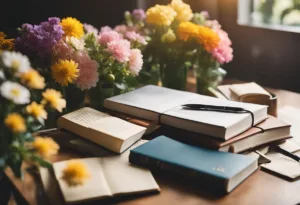Journaling has been a popular practice for many years, and it has been proven to have many benefits for individuals who practice it regularly. One of the most significant benefits of journaling is its ability to enhance creativity. In this blog post, I will share with you how to start Journaling for Creativity, benefits, and prompts to use in your creativity journal.
Journaling is an excellent way to increase self-awareness and personal growth. It can help individuals to become more mindful of their thoughts and feelings, which can lead to a better understanding of themselves. This increased self-awareness can also help individuals to identify their strengths and weaknesses, which can be useful in developing their creativity. By understanding their strengths and weaknesses, individuals can focus on developing their strengths and work on overcoming their weaknesses, which can lead to increased creativity.
Understanding Journaling and Creativity
Journaling is a powerful tool that can help unlock creativity and facilitate self-reflection. It is a process of writing down thoughts, feelings, and experiences in a structured or unstructured way. Journaling has been used for centuries as a way to explore one’s innermost thoughts and emotions, and it has been shown to have numerous benefits for creativity.
The Science of Journaling for Creative Thought
Research has found that journaling can help improve focus, self-awareness, and emotional regulation. By writing down thoughts and feelings, individuals can gain a deeper understanding of their creative process and identify patterns that may be hindering their creativity. Journaling can help reduce stress and anxiety, which can be major barriers to creative thinking.
Studies have also shown that journaling can improve memory and cognitive function, which are essential for creative thought. When individuals write down their ideas, they are more likely to remember them and build upon them in the future. Furthermore, journaling can help individuals generate new ideas and solutions to problems by allowing them to explore different perspectives and possibilities.
Different Journaling Techniques and Styles
There are many different techniques and styles of journaling that can be used to enhance creativity. One popular technique is stream of consciousness writing, where individuals write down whatever comes to mind without worrying about structure or grammar. This can help individuals tap into their subconscious and generate new ideas.
Another technique is creative writing, which involves using prompts or exercises to inspire creativity. This can include writing short stories, poetry, or even just jotting down random words or phrases. Creative writing can help individuals break out of their comfort zones and explore new ideas and perspectives.
The key to using journaling for creativity is to find a style that works for the individual. Whether it’s structured or unstructured, focused or free-flowing, journaling can be a powerful tool for unlocking creativity and enhancing self-reflection.
Benefits of Journaling for Creativity

Enhances Problem-Solving Skills
Journaling for creativity acts as a catalyst for problem-solving. When you write down issues or challenges, your brain starts to process them in different ways. By engaging in free-flowing thought without the fear of judgment, you can stumble upon innovative solutions that might not have surfaced in a more structured thinking process.
Journaling provides a safe space to explore various scenarios and “what if” questions, allowing your mind to wander through possibilities that can lead to creative breakthroughs. The act of writing can also help to clarify complex problems by breaking them down into more manageable parts, making it easier to tackle each aspect creatively.
2. Provides a Creative Outlet
Journaling serves as an unrestricted outlet for your thoughts and ideas. It’s a place where you can experiment with new concepts, play with language, and express your innermost thoughts without the constraints of formalities or the pressures of an audience.
This freedom encourages the flow of creativity as you’re able to let your guard down and explore the depths of your imagination. Over time, the habit of journaling can help you develop a more creative mindset, as you become accustomed to expressing yourself in novel and diverse ways.
3. Encourages Mindfulness and Presence
The practice of journaling can enhance mindfulness by focusing your attention on the present moment. As you write about your current experiences, thoughts, and feelings, you become more attuned to the details of your surroundings and your internal state.
This heightened awareness can fuel creativity by inspiring you to notice and appreciate nuances that might otherwise go unnoticed. Mindfulness through journaling also helps in reducing anxiety and mental clutter, which can obstruct the creative process. By being present, you clear a path for fresh ideas to emerge.
4. Aids in Overcoming Creative Blocks
Journaling is a powerful tool for overcoming creative blocks. When you’re feeling stuck, the simple act of writing can help get your creative juices flowing again. The process of putting pen to paperor fingers to keyboard can trigger new connections and insights, even if you start by writing about your block itself.
Journaling can also help you identify patterns or triggers that lead to these blocks, allowing you to address and prevent them in the future. By regularly engaging with your journal, you can maintain a steady stream of creativity and reduce the frequency and impact of creative dry spells.
5. Facilitates Personal Reflection and Growth
Creativity is closely linked to personal growth and self-understanding. Journaling provides an opportunity for deep reflection, enabling you to explore your beliefs, goals, and fears. Understanding your personal narrative can inspire creative expression and help you to craft more authentic and resonant work.
Reflecting on past journal entries allows you to track your creative evolution over time, revealing how your ideas and style have developed. This self-awareness can be incredibly motivating, as it highlights your progress and encourages you to push your creative boundaries.
6. Cultivates a Habit of Regular Writing
The more you engage in any skill, the better you become, and journaling is no exception. By committing to regular writing sessions, you’re effectively practicing and honing your ability to articulate thoughts and ideas.
This discipline can transfer to other areas of creativity, as the process of regular writing instills a sense of commitment and work ethic that is essential for any creative endeavor. The habit of journaling also ensures that you’re capturing a wide array of thoughts and inspirations that can later be mined for creative projects.
7. Acts as a Repository for Ideas and Inspiration
A journal is a treasure trove of ideas and inspirations that you can revisit at any time. Whenever you encounter something intriguing; a quote, an image, a conversation—you can record it in your journal. These entries can serve as seeds for creative projects, and the act of writing them down helps to solidify them in your memory.
When you’re in need of inspiration, flipping through past journal entries can provide a spark that ignites your next creative work. Your journal becomes a personal catalog of creativity that is uniquely yours.
How to Start Journaling For Creativity

- Choose Your Medium
- Decide whether you prefer a physical notebook or a digital platform for your journal.
- Set a Regular Time
- Dedicate a specific time each day or week to write in your journal.
- Create a Comfortable Environment
- Find a quiet space where you can write without interruptions.
- Start with Free Writing
- Begin each session by writing whatever comes to mind to warm up your creative muscles.
- Use Creative Prompts
- If you’re stuck, use prompts to kickstart your writing.
- Reflect on Your Entries
- Take time to look back on what you’ve written and identify any emerging patterns or ideas.
- Keep it Private
- Remember that your journal is a personal space, free from the scrutiny of others.
20 Prompts for Journaling For Creativity
- Write about your favorite childhood memory.
- Describe a world where a certain color doesn’t exist.
- What would you do if you could live a day without consequences?
- Create a character based on a plant.
- Write a letter from the perspective of your future self.
- Describe the most unusual place you can imagine.
- Invent a new holiday and how it’s celebrated.
- Write about a day in the life of an inanimate object.
- Imagine a conversation between the moon and the sun.
- Create a story that starts with a dream.
- Describe your perfect creative space.
- Write a poem about a journey, physical or metaphorical.
- What superpower would you choose to have and why?
- Write about a tradition from a culture that doesn’t exist.
- Create a myth to explain why the sky changes color at sunset.
- Describe a moment you felt completely at peace.
- If you could speak to one species of animals, which would it be and what would you say?
- Write about an invention that changes the way society functions.
- Describe a scent that brings back memories.
- Write a story where time moves backward.
Setting Up Your Creativity Journaling Practice

Journaling can be a powerful tool to boost creativity and self-awareness. However, setting up a journaling practice can be daunting for beginners. This section will guide you through the process of setting up your journaling practice by choosing the right journal and tools, and creating a conducive environment for journaling.
Choosing the Right Journal and Tools
Choosing the right journal and tools is essential to get started with journaling. There are many types of journals available in the market, ranging from blank pages to journals with prompts. Blank journals are ideal for those who prefer to write freely without any structure, while journals with prompts provide a framework to guide your writing.
When choosing a journal, consider the size, paper quality, and binding. A journal that is easy to carry and has good paper quality will make it easier to write on the go. Consider the binding of the journal; a spiral-bound journal allows you to lay the pages flat, making it easier to write.
In terms of tools, a good pen or pencil is essential. Choose a pen that is comfortable to hold and writes smoothly. Consider using colored pens or highlighters to make your writing more engaging.
Creating a Conducive Environment for Journaling
Creating a conducive environment for journaling can help you get into the right mindset for writing. Find a quiet and comfortable place to write, away from distractions. Consider using aromatherapy or listening to music to create a relaxing atmosphere.
Organizing your journaling supplies can also help you get into the right mindset for writing. Keep your journal and writing tools in a designated place, so you can easily access them when you want to write. Journal prompts can also be helpful in getting started with writing. Consider using prompts to guide your writing and spark your creativity.
Journaling Exercises to Enhance Creativity

Journaling is a great way to enhance creativity. It can help you tap into your inner thoughts and ideas, and provide a safe space to explore them. Here are some journaling exercises that can help you boost your creativity:
Using Prompts to Spark Ideas
One way to get started with journaling is to use prompts. Prompts are questions or statements that can help you jumpstart your creativity. You can find prompts online or come up with your own. Some examples of prompts include:
- What inspires you?
- Write about a time when you overcame a challenge.
- What are your goals for the future?
Using prompts can help you explore your thoughts and ideas in a structured way. It can also help you get past writer’s block and spark new ideas.
Exploring Stream of Consciousness Writing
Stream of consciousness writing is a technique where you write down whatever comes to mind without worrying about grammar, punctuation, or spelling. It’s a great way to explore your thoughts and ideas without any restrictions.
To try this technique, set a timer for 10-15 minutes and write down whatever comes to mind. Don’t worry about making sense or being coherent. Just write down whatever comes to mind. You might be surprised by what you come up with.
Visual and Mixed Media Techniques
Another way to enhance your creativity through journaling is to use visual and mixed media techniques. This can include drawing, painting, collaging, or using stickers and other embellishments to decorate your journal pages. Using mixed media techniques can help you explore your thoughts and ideas in a different way. It can also help you tap into your senses and emotions, which can lead to new ideas and insights.
Journaling can be a powerful tool for enhancing creativity. By using prompts, stream of consciousness writing, and visual and mixed media techniques, you can explore your thoughts and ideas in new and exciting ways.
Overcoming Creative Blocks with Journaling
Journaling can be an effective tool for overcoming creative blocks. By putting pen to paper and allowing thoughts to flow freely, writers can identify and address the root causes of their writer’s block. In this section, we’ll explore some techniques for using journaling to overcome creative blocks.
Identifying and Addressing Writer’s Block
One of the first steps in overcoming writer’s block is identifying its root cause. Journaling can help writers gain clarity on what’s holding them back. By writing down their thoughts and feelings, writers can identify patterns and triggers that may be contributing to their creative blocks.
Once writers have identified the root cause of their writer’s block, they can use journaling to address it. For example, if self-doubt is the cause of their creative block, writers can use journaling to challenge their negative self-talk and build their confidence. By writing down positive affirmations and reminding themselves of their past successes, writers can shift their mindset and overcome their creative blocks.
Techniques for Brain Dumping and Clarity
Another way journaling can help writers overcome creative blocks is by providing a space for brain dumping. Brain dumping is the process of writing down all of one’s thoughts and ideas without judgment or analysis. By doing so, writers can clear their minds of clutter and gain clarity on their creative goals.
One technique for brain dumping is mind mapping. Mind mapping is a visual tool for organizing one’s thoughts and ideas. By creating a visual map of their ideas, writers can see connections and patterns that may not be apparent otherwise.
In addition to mind mapping, writers can use journaling prompts to stimulate their creativity. Prompts can be as simple as asking oneself “what if?” or “why not?” or more complex, such as “write a story from the perspective of a character who has lost their memory.” By using prompts, writers can break out of their creative rut and explore new ideas and perspectives.
Journaling can be a powerful tool for overcoming creative blocks. By identifying the root cause of their writer’s block and using techniques such as brain dumping and mind mapping, writers can gain clarity and stimulate their creativity.
Reflective and Growth-Oriented Journaling
Journaling is a powerful tool that can help individuals foster self-discovery, personal development, and growth. Reflective journaling, in particular, is a practice that encourages individuals to reflect on their experiences, thoughts, and emotions in a structured and intentional way. By doing so, individuals can gain a deeper understanding of themselves, their values, and their goals.
Fostering Self-Discovery and Personal Development
Reflective journaling is an effective way to foster self-discovery and personal development. By reflecting on one’s experiences, thoughts, and emotions, individuals can gain insight into their own behavior and decision-making processes. This insight can help individuals identify areas for improvement and develop strategies to overcome obstacles.
Reflective journaling can also help individuals identify their values and goals. By reflecting on what is important to them, individuals can gain clarity about their priorities and make decisions that align with their values. This can lead to a greater sense of purpose and fulfillment in life.
Gratitude and Mindfulness Practices
In addition to fostering self-discovery and personal development, reflective journaling can also promote gratitude and mindfulness practices. Gratitude journaling involves reflecting on the things that one is grateful for in life. This practice has been shown to have numerous mental health benefits, including increased happiness, reduced stress, and improved relationships.
Mindfulness journaling involves reflecting on one’s thoughts and emotions in a non-judgmental way. This practice can help individuals become more aware of their thoughts and emotions and develop a greater sense of self-awareness. This can lead to improved mental health and well-being.
Reflective and growth-oriented journaling can be a powerful tool for individuals looking to improve their mental health, foster self-discovery, and promote personal development. By incorporating gratitude and mindfulness practices into their journaling, individuals can gain even greater benefits from this practice.
Frequently Asked Questions
How can one incorporate journaling into a daily routine to enhance creativity?
Journaling can be incorporated into a daily routine by setting aside a specific time each day to write. It is recommended to write in the morning, as this allows for reflection on the previous day and sets the tone for the day ahead. It is important to write without judgment and to allow for free-flowing thoughts and ideas. This can help to enhance creativity by providing an outlet for self-expression and allowing for the exploration of new ideas.
What are some techniques for using a journal to improve creative writing skills?
One technique for using a journal to improve creative writing skills is to practice writing prompts. This can include writing about a specific topic or using a word or phrase as inspiration. Another technique is to use the journal as a place to experiment with different writing styles and formats. This can help to develop a writer’s voice and improve their ability to convey ideas effectively.
Can you provide examples of creative journal entries that demonstrate innovative thinking?
Examples of creative journal entries that demonstrate innovative thinking can include brainstorming sessions, mind maps, and creative writing exercises. These entries can be used to explore new ideas, develop creative solutions to problems, and to experiment with different writing styles and formats.
What is the difference between traditional journaling and bullet journaling for creative purposes?
Traditional journaling involves writing free-flowing thoughts and ideas in a notebook or journal. Bullet journaling, on the other hand, involves using a system of symbols and bullet points to organize thoughts and ideas. While both methods can be used for creative purposes, bullet journaling is often used for planning and organization, while traditional journaling is used for self-expression and reflection.
How does morning journaling influence creative thought processes throughout the day?
Morning journaling can influence creative thought processes throughout the day by providing a space for reflection and self-expression. By starting the day with journaling, individuals can set the tone for the day ahead and allow for free-flowing thoughts and ideas. This can help to enhance creativity by providing an outlet for self-expression and allowing for the exploration of new ideas.
In what ways does journaling differ from morning pages when focusing on creative development?
Journaling and morning pages both involve writing free-flowing thoughts and ideas, but they differ in their purpose and approach. Journaling is often used for self-expression and reflection, while morning pages are used as a tool for creative development. Morning pages involve writing three pages of stream-of-consciousness writing first thing in the morning, without judgment or editing. This can help to clear the mind and allow for new ideas to emerge.




